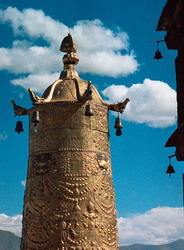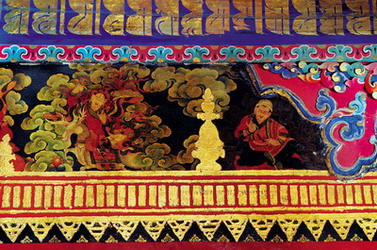Golden tiled roofs are typically seen on the halls and dagobas of monasteries. They are a lofty and luxurious building decoration made of bronze with gold gild. This building decoration and building style is an exclusive possession of Tibet.
The gilded bronze, tube-like tiles used to form the roof have upturned eaves at four corners each has an open-mouthed huge legendary turtle. The roof is decorated with Buddhist umbrellas and bottles and reclining deer. And the eaves are carved with such patterns as Dharma wheel, clouds, Six Syllable Prayer, lotus beads and auspicious patterns. Between the bottles on the roof and under the eaves are hung bells which produce a pleasant sound.

This serves as a significant part in the decoration of such buildings as palaces, monasteries, and Buddhist dagobas, and an exclusive contribution Tibet to world architectural art. Putting golden tiled roofs on such buildings aims at giving prominence to the main buildings and making them seem more magnificent and grand.
The tiled roofs come in many different measurements. Some are more than 200 square meters and about 5 meters high. Some are as small as 20 square meters and about 2 meters high. Whether palaces, monasteries and other buildings have such a golden top and whether it is large or small, it was long a significant symbol of a masters' wealth and nobility as well as demonstrating his political and religious power due to strict stipulations on qualification in a well-defined hierarchy.
Take the Gelug Sect as an example. The buildings that were qualified for the golden tiled roofs include 1, monasteries that were built in the birthplace of Zongkapa, founder of the Gelug Sect, and those built by disciples taught by himself; 2, the living places of the Dalai Lama, Panchen Lama and Tibetan kings of past dynasties; 3, monasteries from which came the Gandain Chiba (abbot of the Gandain Monastery of the Gelug Sect); 4, monasteries in the birthplaces of the Dalai Lamas of past dynasties; 5, monasteries, palaces or Buddhist dagobas that once made special contribution to the government and the religion of the Tibetan ethnic group and were granted privileges by Gandain Chiba and the Dalai Lama to build such a golden top; other monasteries, palaces and Buddhist dagobas had no right or were not qualified.

People of the Tibetan ethnic group have a long history of using golden tops. There is a view that it was created by the Tibetan ethnic group themselves, while another view favors an Indian origin. From the tangka paintings preserved in the Lhasa Potala Palace and the mural pictures in the Samye Monastery, it can be seen that the Potala Palace, the Jokhang Monastery, and the Norbu Lingka, etc., the Yongbulhakang constructed before 800 A.D., Potala Palace and the Jokhang Monastery constructed in early 7th century, and the Samye Monastery constructed in 736 all had golden tops. According to A General Record of Tibetan Kings, Records of Tibetan kings and Ministers, Blue Annals, Red Annals, Records of the Samyas Monastery, and other historical records, when Tibetan king Songtsan Gambo (617-697) built Jokhang Monastery in Lhasa in honor of the Nepalese Prince Bribhuti, the roof of the holy palace was decorated with pure gold tiles and other decorations. In 736, when the Tibetan king Trisum Detsan (742-797) established the Samye Monastery, the first monastery complete in Buddhist doctrines, dharma and monks, in what is today's Zhanang County of Tibet, the historical record shows that the main hall, the surrounding four big halls and eight small halls, and the three holy palaces for the three queens of Trisum Detsan all had golden tiles. According to historical records, the roofs, poles and girders of the Toding Monastery of the Guge Kingdom in Ngari that was constructed in 940 were all constructed with gold.
From the 10th century to 19th century, more than five thousand big or small monasteries of Buddhism and Benbo religion were built up in the Tibetan-inhabited area. Among them in more than 100 monasteries the main halls and some important halls had a golden top. Many famous palaces and Buddhist dagobas were similarly blessed, but it is a pity that there are only a few preserved today. Since 1980, monasteries in various places have been reconstructed, and some have golden tops. But they are incomparable with the monasteries that existed before in such aspects as the scale, construction techniques and gold content because many special crafts and techniques have been lost.
